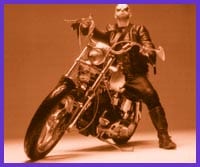The oddest thing about gay heavy metal icon Rob Halford’s show last week wasn’t the overwhelming welcome he got from the crowd, it was how much gayer headliners Iron Maiden were.
Until 1991, Halford was the singer of metal legends Judas Priest. Halford was so popular that he became known as the “Metal God.” So when he came out in 1998 – the first and maybe only metal artist to do so – the question of how metalheads around the world would react was on everyone’s mind.
Well, judging by the adoration heaped on Halford at his Air Canada Centre show, his fans are simply relieved that he abandoned his last album’s ill-fated techno collaboration with Trent Reznor of Nine Inch Nails. No one in the crowd called him a fag; people just told him he raaawked.
Perhaps the reaction isn’t surprising. Heavy metal may be a bastion of mindless machismo, but it’s also the genre of rock that plays around the most with notions of masculinity and sexuality.
Metal, much of it, portrays a hyper-masculinized world, not unfamiliar to many gay men. Songs tell of warriors, soldiers or bikers. Cover art shows pumped-up biceps which would fit right into a Tom Of Finland collection.
Halford, too, was part of that tradition. He claims his record company forced him to conceal his sexuality, but long before he came out, he was the epitome of the leatherman. Britain’s Q magazine once described him as “a shrieking, leather-clad, stud-encrusted pantomime dame, whose stage wardrobe included a leather cap, handcuffs and bullwhip.”
Outside of the metal world, Halford would have been recognized instantly as queerer than a three-dollar bill.
In his Toronto show, Halford still looks like he came straight from the Black Eagle, and one of his first songs, “Locked And Loaded,” must be about blowjobs: “I’ll bring you to your knees/ And give you what you please… I’m gonna shoot it/ I’m gonna shoot it/ Cause I’m locked and loaded.” The crowd roars its approval, and just about everyone flashes the devil’s horns.
Maybe they aren’t aware that he’s gay, cheering in studied ignorance, or maybe they just don’t care. Metal, at least in its mainstream, has never thrown its tattooed arms open to gay men, but neither has it always responded with the hostility found in mainstream rock or punk. Metal has provided very mixed signals, as epitomized on this night by Iron Maiden.
In the mid-’80s – really metal’s last popular gasp – the genre was dominated by so-called “hair metal” bands, like Poison, Ratt or Motley Crue, whose lead singers looked like worn-out, third-rate drag queens.
And although Maiden was never a hair band, they sure look like it on stage. The three guitarists all have long, teased and dyed hair, wear spandex and multi-coloured bandannas and literally skip across the stage, dropping to their knees at a moment’s notice. Singer Bruce Dickinson acts like a demented aerobics instructor, and when a guitarist holds his instrument so Dickinson can play it for him, the homoeroticism is overwhelming. The crowd merely cheers louder.
That’s not to say that there aren’t disturbing aspects to Maiden’s set. When you have an overwhelmingly white male crowd pumping fists in unison and chanting “Two minutes to midnight” or “They can’t take any more from us,” it inspires disturbingly Nurembergian images of a countdown to race war (ostensibly, “Two Minutes To Midnight” is about nuclear annihilation).
It doesn’t help that Dickinson is running around waving the Union Jack. It’s overstating the case, but it’s reminiscent of The Wall, where a concert crowd’s mass behaviour is equated to demagogic fascism.
Truth is, the further you get from mainstream metal, the more homophobic things get.
When bands cross metal with hard rock (Guns ‘N’ Roses or Limp Bizkit) or hardcore (Pantera or Agnostic Front), the race- and gay-baiting seems to increase exponentially.
And when you get into black or death metal, especially from Scandinavia, things get downright insane. Which is why it’s strange that the opening act at Halford’s concert is Sweden’s Entombed.
Entombed may confine themselves to singing about death and the devil, but the scene they come from goes much further. Norway’s Mayhem broke up when vocalist Dead shot himself to death, only to have his brain cooked and eaten by a bandmate, who was later stabbed to death by the bassist, who is working, in jail, on his thesis that Nazism was a response to a Judeo-Christian conspiracy. Emperor guitarist Samoth was sentenced to 16 months for burning down a church and drummer Faust got 14 years for stabbing a gay man to death.
How Halford would be received in Scandinavia is open to question, and it’s not likely that we’re going to see a wave of gay metal bands any time soon. But as Halford sings in “Resurrection,” “I rid the demons from my heart/ And found the truth was with me from the start.”


 Why you can trust Xtra
Why you can trust Xtra


